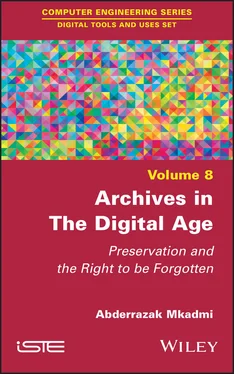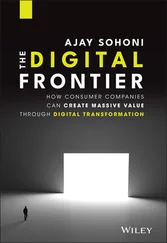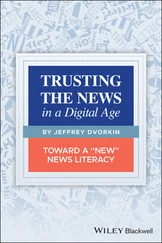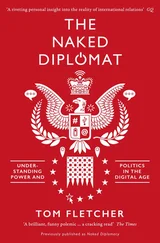3 Chapter 3Table 3.1. Extract from the Data dictionary for the semantic unit object charact...
4 Chapter 5Table 5.1. Dissemination rules for public archives and research tools [FRA 20]
1 Cover
2 Table of Contents
3 Title Page Digital Tools and Uses Set coordinated by Imad Saleh Volume 8
4 Copyright First published 2021 in Great Britain and the United States by ISTE Ltd and John Wiley & Sons, Inc. Apart from any fair dealing for the purposes of research or private study, or criticism or review, as permitted under the Copyright, Designs and Patents Act 1988, this publication may only be reproduced, stored or transmitted, in any form or by any means, with the prior permission in writing of the publishers, or in the case of reprographic reproduction in accordance with the terms and licenses issued by the CLA. Enquiries concerning reproduction outside these terms should be sent to the publishers at the undermentioned address: ISTE Ltd 27-37 St George’s Road London SW19 4EU UK www.iste.co.uk John Wiley & Sons, Inc. 111 River Street Hoboken, NJ 07030 USA www.wiley.com © ISTE Ltd 2021 The rights of Abderrazak Mkadmi to be identified as the author of this work have been asserted by him in accordance with the Copyright, Designs and Patents Act 1988. Library of Congress Control Number: 2021930486 British Library Cataloguing-in-Publication Data A CIP record for this book is available from the British Library ISBN 978-1-78630-676-0
5 Preface
6 Introduction
7 Begin Reading
8 Conclusion
9 List of Acronyms
10 References
11 Index
12 End User License Agreement
1 v
2 iii
3 iv
4 ix
5 x
6 xi
7 xii
8 xiii
9 xiv
10 xv
11 1
12 2
13 3
14 4
15 5
16 6
17 7
18 8
19 9
20 10
21 11
22 12
23 13
24 14
25 15
26 16
27 17
28 18
29 19
30 20
31 21
32 22
33 23
34 24
35 25
36 26
37 27
38 28
39 29
40 30
41 31
42 32
43 33
44 34
45 35
46 36
47 37
48 38
49 39
50 40
51 41
52 42
53 43
54 44
55 45
56 46
57 47
58 48
59 49
60 50
61 51
62 52
63 53
64 54
65 55
66 56
67 57
68 58
69 59
70 60
71 61
72 62
73 63
74 64
75 65
76 66
77 67
78 68
79 69
80 71
81 72
82 73
83 74
84 75
85 76
86 77
87 78
88 79
89 80
90 81
91 82
92 83
93 84
94 85
95 86
96 87
97 88
98 89
99 90
100 91
101 92
102 93
103 94
104 95
105 96
106 97
107 98
108 99
109 100
110 101
111 102
112 103
113 104
114 105
115 106
116 107
117 108
118 109
119 110
120 111
121 112
122 113
123 114
124 115
125 116
126 117
127 118
128 119
129 120
130 121
131 122
132 123
133 124
134 125
135 126
136 127
137 128
138 129
139 130
140 131
141 132
142 133
143 134
144 135
145 136
146 137
147 138
148 139
149 140
150 141
151 142
152 143
153 144
154 145
155 146
156 147
157 148
158 149
159 150
160 151
161 152
162 153
163 154
164 155
165 156
166 157
167 158
168 159
169 160
170 161
171 162
172 163
173 164
174 165
175 166
176 167
177 168
178 169
179 170
180 171
181 172
182 173
183 174
184 175
185 176
186 177
187 178
188 179
189 181
190 182
191 183
192 184
193 185
194 186
195 187
196 188
197 189
198 190
199 191
200 192
201 193
202 194
203 195
204 196
205 197
206 198
207 199
208 200
209 201
210 202
211 203
212 204
213 205
214 206
215 207
216 208
217 209
218 210
219 211
220 212
221 213
222 214
223 215
224 216
225 217
226 218
227 219
228 220
229 221
230 223
Digital Tools and Uses Set
coordinated by
Imad Saleh
Volume 8
Archives in The Digital Age
Preservation and the Right to be Forgotten
Abderrazak Mkadmi

First published 2021 in Great Britain and the United States by ISTE Ltd and John Wiley & Sons, Inc.
Apart from any fair dealing for the purposes of research or private study, or criticism or review, as permitted under the Copyright, Designs and Patents Act 1988, this publication may only be reproduced, stored or transmitted, in any form or by any means, with the prior permission in writing of the publishers, or in the case of reprographic reproduction in accordance with the terms and licenses issued by the CLA. Enquiries concerning reproduction outside these terms should be sent to the publishers at the undermentioned address:
ISTE Ltd
27-37 St George’s Road
London SW19 4EU
UK
www.iste.co.uk
John Wiley & Sons, Inc.
111 River Street
Hoboken, NJ 07030
USA
www.wiley.com
© ISTE Ltd 2021
The rights of Abderrazak Mkadmi to be identified as the author of this work have been asserted by him in accordance with the Copyright, Designs and Patents Act 1988.
Library of Congress Control Number: 2021930486
British Library Cataloguing-in-Publication Data
A CIP record for this book is available from the British Library
ISBN 978-1-78630-676-0
Digital archiving is not storing data, but rather keeping it in an intelligent way in order to be able to exploit it over time while maintaining its integrity and authenticity. With the rapid transformations caused by the use of computer tools, several types of documents are nowadays stored with and served by archive services: email, databases, digital photographs, digital audiovisual content, exchanges on social media, etc. We are thus witnessing an evolution of the concepts and practices in the human and social sciences toward what we call “digital humanities”. This has led to the development of new tools and applications that promote access to and use of archives. At the same time, there has been an explosion of documents and information emanating from, inter alia, mobile technologies, social media, online transactions and connected sensors, which must be collected, preserved and disseminated. Commonly known today as Big Data, these megadata use very powerful technologies, which tend to store everything and for a long period of time. However, this concern to preserve everything in the name of the right to remember is confronted with another right, that of being forgotten. This right is often linked to the freedom of individuals who are condemned to living without privacy and freedom by being faced with the mistakes of their past.
This book attempts to provide a general overview of the complexity of the evolution of the concept of digital archives through three dimensions: human and social, technical and legal. It first presents the contours and necessary elements of its definitions, as well as the methods and strategies of digital archiving while presenting the normative landscape governing the field. The book then details the changes undergone by archives in the digital humanities in terms of content, media, preservation and access. It then tries to show the extent to which the arrival of Big Data has changed the work of archivists. The challenge is to process more data, at a lower cost and in a shorter timeframe. In this context, blockchain as a decentralized and distributed registry is presented as a complementary solution to digital archiving. Finally, special attention will be given to the legal and technical dimensions of archive processing through the right to be forgotten.
Читать дальше












